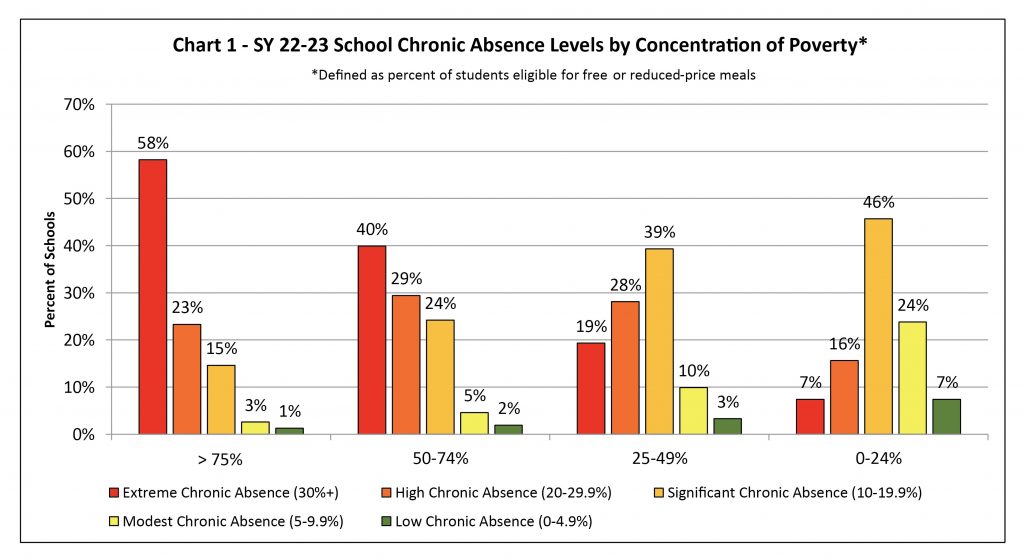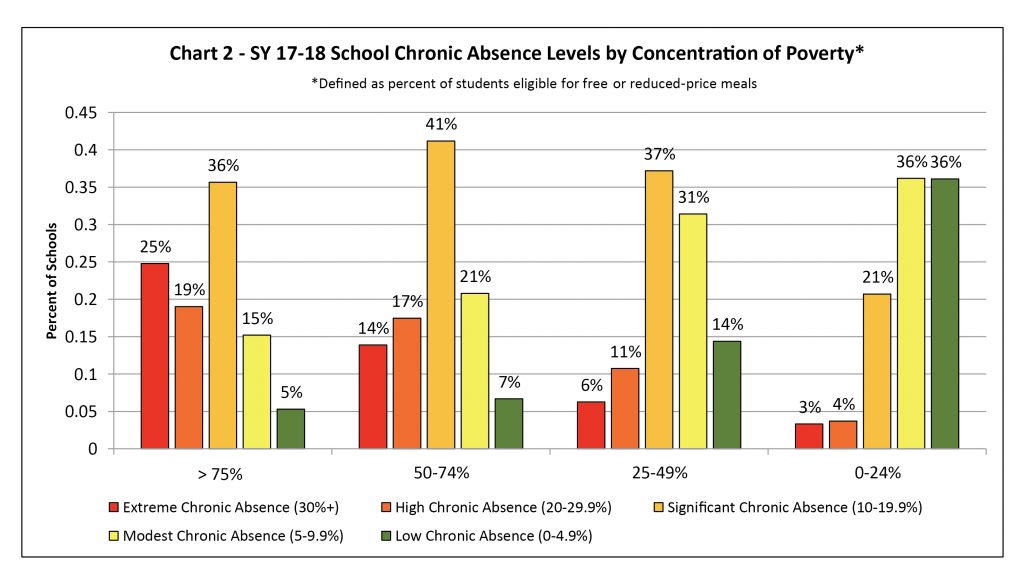By Hedy Chang, Executive Director, Attendance Works; Robert Balfanz, Director, Everyone Graduates Center, Johns Hopkins University; and Vaughan Byrnes, Senior Research Associate, Everyone Graduates Center, Johns Hopkins University.
The recent release of national data for the 2022-23 school year by the U.S. Department of Education confirms that while modest improvements in reducing chronic absence are occurring, it remains a challenge nearly everywhere. And just like student achievement in math and reading, chronic absence rates aren’t going to improve without our ongoing attention and action.
Equally troubling in 2022-23, two years after schools reopened for in-person learning, a majority of students still attended schools with 20% or higher levels of chronic absence. This serious absenteeism is in stark contrast to 2019, when slightly over a quarter of schools experienced such high levels of chronic absence.
Persistently high levels still challenge schools
In the 2022-23 school year, this meant that for the average-sized school, there were at least 88 chronically absent students in each elementary school, 113 in each middle school and 139 students in each high school. Such high numbers of chronically absent students are beyond the capacity of a single social worker or counselor to address. Research shows how such elevated levels of chronic absence can overwhelm school staff and negatively affect teaching and learning for all students, not just for those who aren’t in school.
Attendance Works and the Everyone Graduates Center at Johns Hopkins University joined together to analyze this national data and examine changes over time. We found seven significant take-aways:
- Chronic absence slightly decreased from its high of 30% of students in the 2021-22 school year to 28% in 2022-23. This means that chronic absence remained highly elevated during the second year of in-person schooling for students, even though during the 2022-23 school year, attendance was not affected by widespread Covid-19 outbreaks.
- While chronic absence was decreasing for all student groups, sizable gaps remained. Every student group saw a decrease in chronic absence. While some student groups (Native American, Pacific Islander, Black and Hispanic students, students with disabilities and English language learners) continued to experience much higher rates, it is also encouraging to see some were experiencing slightly larger decreases. Click here to see demographic data.
- Most states were seeing reductions, but progress was uneven. As this state comparison data chart reveals, chronic absence declined in most states, although a few experienced increases. And within states, progress towards improved attendance was uneven across districts, according to a study from the Everyone Graduates Center at Johns Hopkins University.
- High levels of school chronic absence remained a substantial challenge. In the 2022-23 school year, 61% of schools had high or extreme levels of chronic absence, compared with 65% in 2021-22 and only 28% pre-pandemic. See Table 1 below. When chronic absence levels are greater than 20% in a school, the impact affects all students, not just the ones who are chronically absent. The churn from students in the classroom makes it harder for teachers to teach and set classroom norms while students must wait for their absent peers to catch up. This can be seen in a study of elementary schools in Delaware, showing that high overall levels of absence in kindergarten through third grade had an even more adverse impact on student learning than individual absences.
High levels of chronic absence also can affect students’ ability to socially integrate. When 20% of students in a school are chronically absent, it can make it harder for students to feel a part of classroom interactions when they actually are in school, and may also send the message to all students that missing school is acceptable. When one student frequently misses school, peers are more likely to do the same, according to research on elementary students.
 More recent data available from states can show that extreme and high levels of chronic absence are a persistent challenge. For example, this analysis of California data, found that in the 2023-24 school year, more than half of all schools still experienced chronic absence rates of 20% or higher.
More recent data available from states can show that extreme and high levels of chronic absence are a persistent challenge. For example, this analysis of California data, found that in the 2023-24 school year, more than half of all schools still experienced chronic absence rates of 20% or higher. - The greatest decreases were among the schools with the highest levels of chronic absence; there was no improvement in the percent of schools with lower chronic absence levels. The percentage of schools with 30% or greater chronic absence decreased from 43% to 36% in the 2022-23 school year. Meanwhile, the percent of schools with low or modest chronic absence rates (less than 10%) was 11% — much, much lower than pre-pandemic when 37% of schools had low or modest rates.
- The majority of schools serving the highest proportion of students experiencing poverty continue to experience extreme levels of chronic absence. As the charts below show, 58% of schools with 75% or more of their students receiving free or reduced price meals had extreme levels of chronic absence. This is a decrease from 68% in the 2021-22 school year, but still more than double the 25% in 2017-18. These high levels of extreme chronic absence are also found among schools serving predominantly non-white student populations as well as schools located in urban areas. See Charts 1 and 2 below. (For more detail see Charts 4a, 4b and 4c in this spreadsheet). These extreme levels of chronic absence occurring in schools with fewer resources make it much harder for schools to ensure students have an equal opportunity to thrive and learn.


- Large numbers of elementary schools continue to be affected by extreme chronic absence levels. The number of elementary schools experiencing 30% or more chronic absence jumped from 3,550 in the 2017-18 school year (prepandemic) to 19,828 in 2021-22 and remained elevated at 15,714 in 2022-23. See Table 2 below. While large numbers of middle and high schools also struggled with extreme levels of chronic absence, elementary schools continued to represent the largest number.

Please note: The federal data for a specific state may look slightly different than what appears on that state’s website. This is because the definition of what constitutes chronic absence and who is counted as absent each day for state websites is determined by each state. This data isn’t necessarily the same as what states submitted to the U.S. Department of Education (Ed Data Express). Nonetheless, the federal data is helpful because it supports examining trends over time and offers more comparability across states, since the federal guidance for the data files applies to all states.
How can we respond?
Tackling such high levels of absenteeism means we must ensure that reducing chronic absence is a top priority at every level: national, state, district, school and community. Whether students show up to school consistently affects the success of most, if not all, efforts to help students learn and thrive. At the same time, as this data shows, re-establishing the positive conditions for learning in schools that motivate showing up and rebuilding a commitment to daily attendance among students and families will not happen overnight but requires persistence and investment over time.
Improving student engagement and attendance involves states and districts setting ambitious but achievable goals like reducing chronic absence by 50% in five years and crafting and implementing a long-term road map for change. It will require a comprehensive approach that leverages powerful and effective strategies including:
- advancing family engagement,
- promoting student connectedness,
- ensuring health, well-being and safety,
- investing in relevant and engaging learning, and
- supporting access to learning.
It requires easier access to real-time chronic absence and attendance data at the school, district and state levels. The Departments of Education in Indiana and Rhode Island have both made easily accessible chronic absence data a key part of efforts to improve student attendance. Such data also can be used to monitor and assess which engagement strategies are working so that resources are used strategically, especially as Covid relief funding ends.
We must advance evidence-based programmatic strategies and improved policies including, for example, community schools, place-based approaches and the actions promoted by the Attendance Solutions Network. Attendance improves when districts and schools partner with families and other agencies to address the challenges that make it hard for students to get to class and affect their ability to learn when they do show up. We can also establish community-wide messaging campaigns that clarify that daily school attendance is a top priority and convey to everyone why it matters for student well-being and success.
The good news
Just like efforts to address learning loss and low test scores, the size and scale of the absenteeism challenge merits and requires an all hands-on-deck approach. The good news is that we have seen substantially improved student engagement and attendance in states including Colorado, Connecticut, Virginia, Rhode Island and New Mexico as well as in districts across the U.S., with each implementing comprehensive, data driven, prevention-oriented approaches.